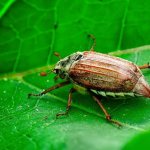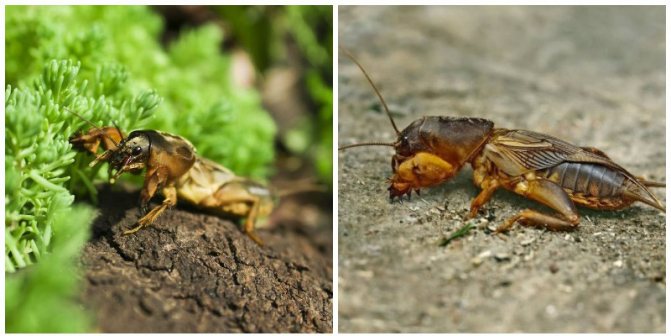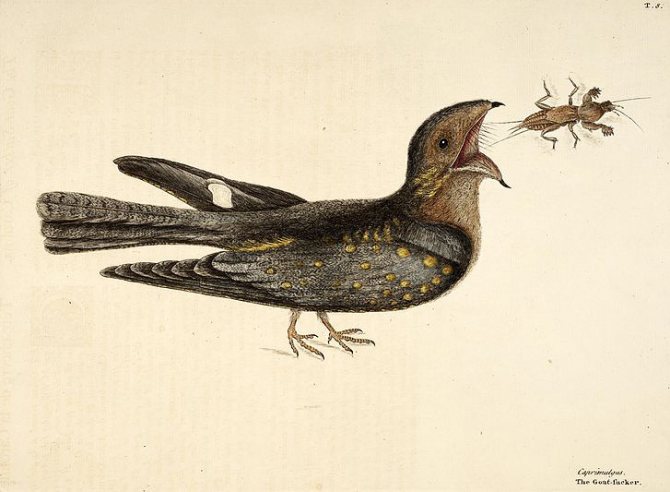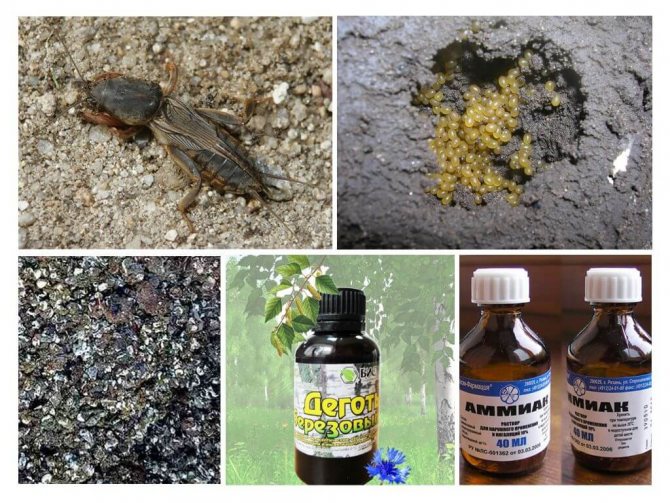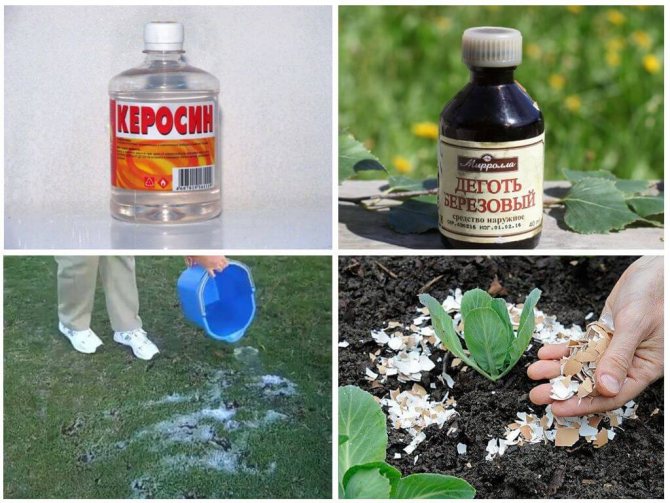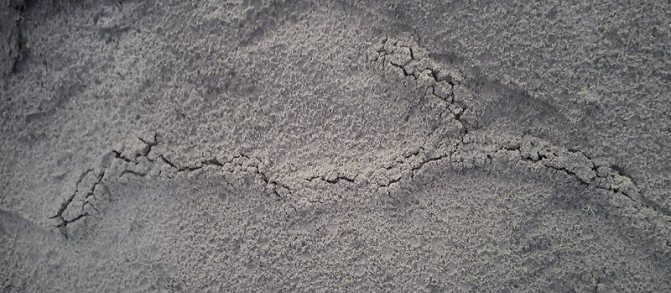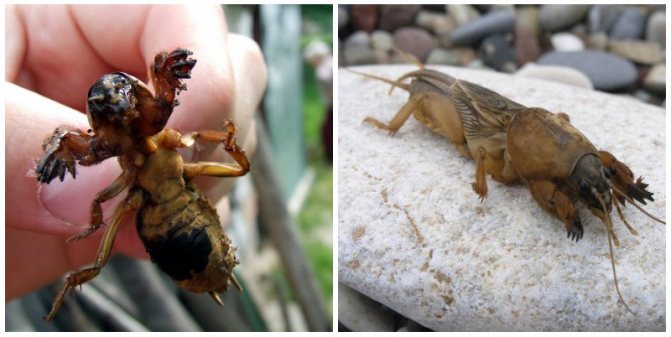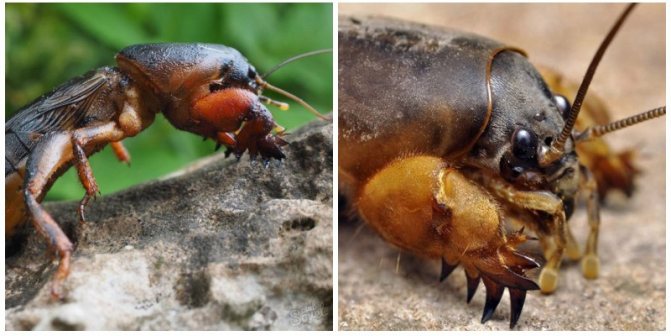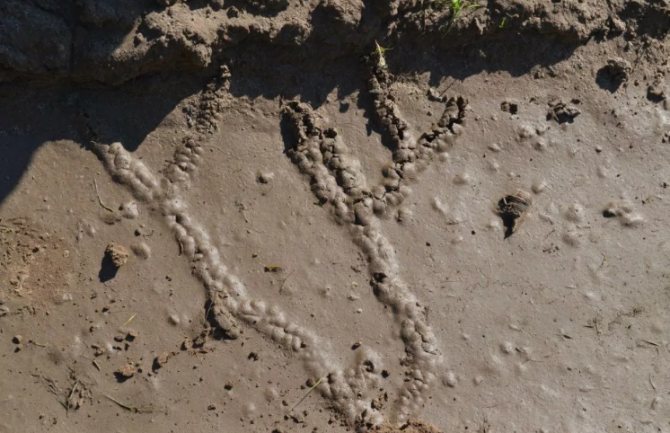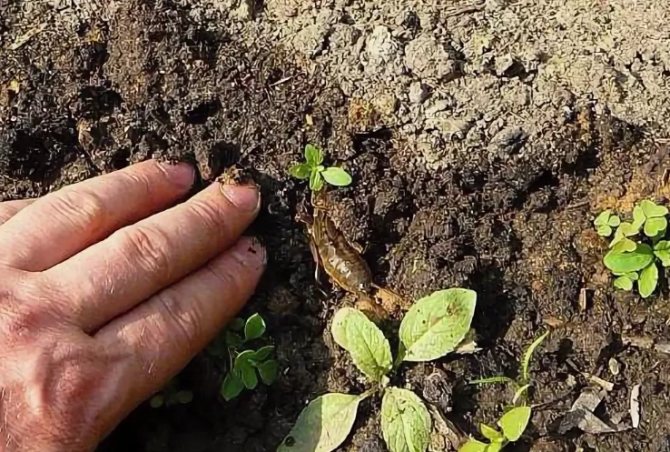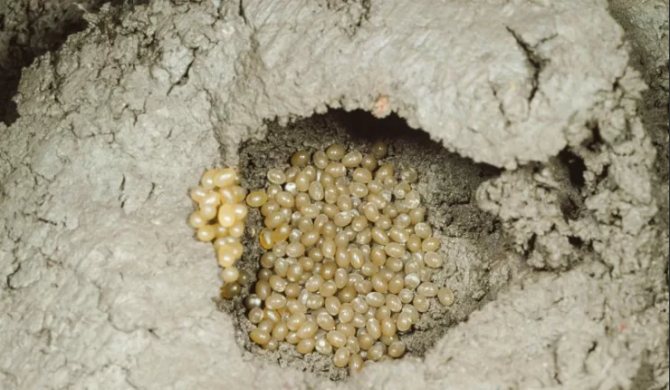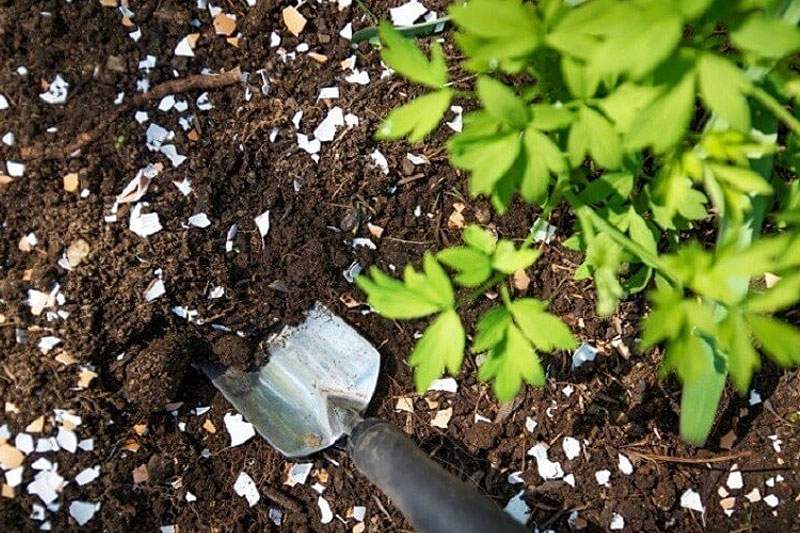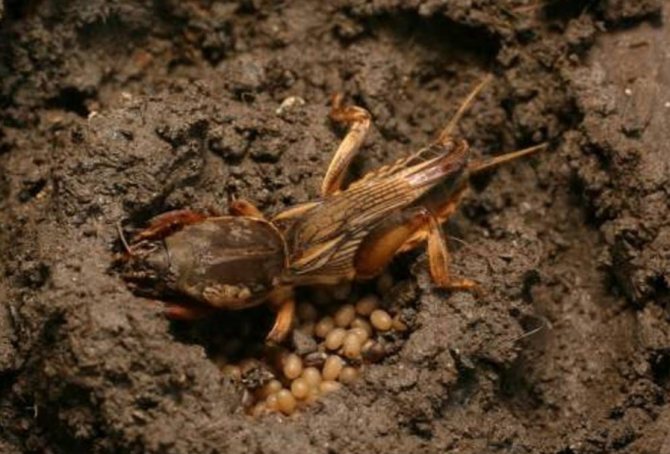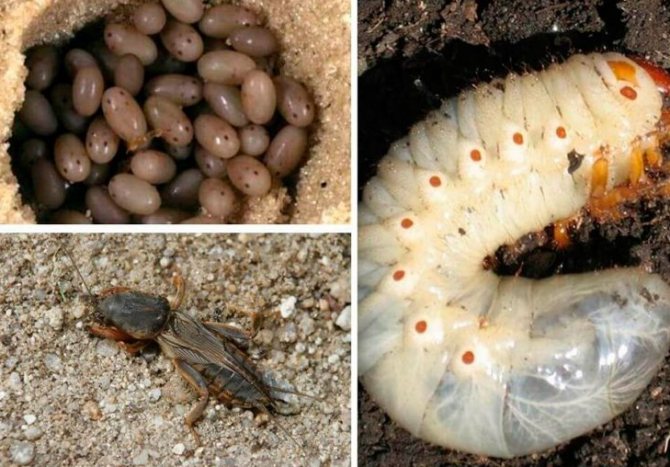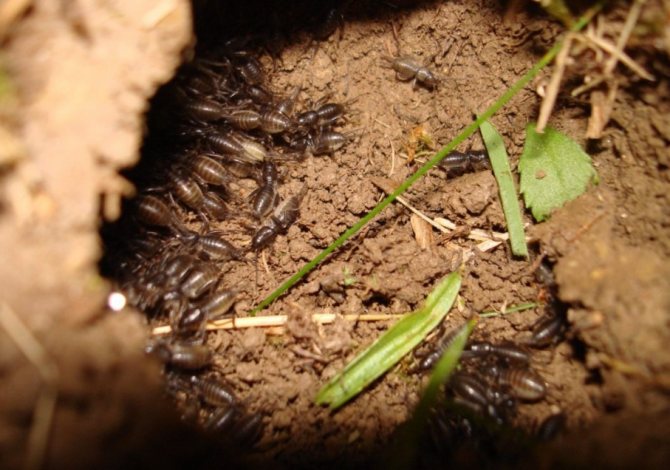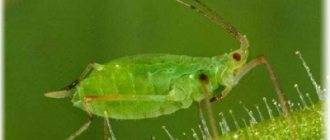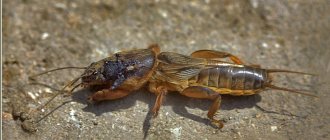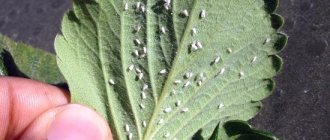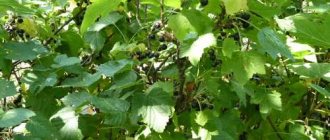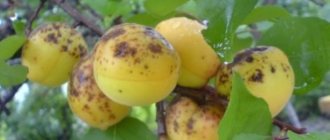How to distinguish a bear from a May beetle?
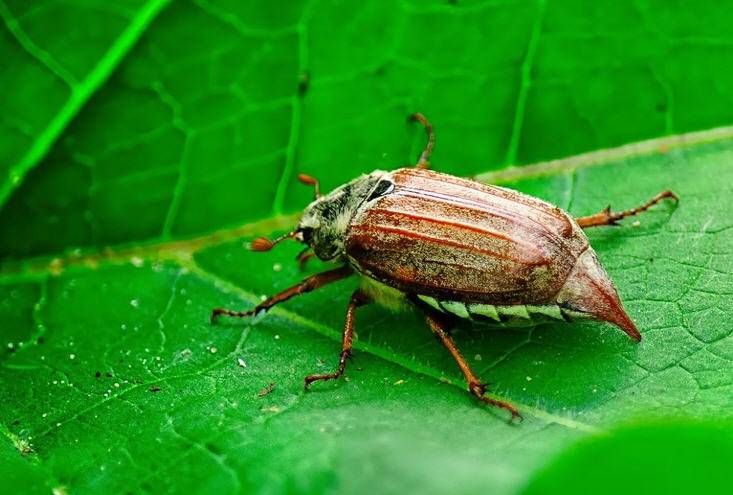
Medvedka
and Khrushchev differ in their way of life, therefore they have a different body structure. Medvedka feeds on plant roots, for which it digs tunnels underground. Therefore, her front pair of limbs has changed, turning into an excellent tool for digging. An adult May beetle lives on the soil surface, feeds on tree leaves and grass.
The difference between the bear and the May beetle is due not only to the different way of life. These insects belong to different groups (orders). May beetle belongs to the order of beetles or beetles and has a typical appearance for this group of insects.
Interesting: coleoptera or beetles are the largest order of living creatures on earth, including almost 400 thousand species. They make up 40% of all insects.
Medvedka belongs to the Orthoptera order. Its closest relatives are not beetles, but grasshoppers, crickets and locusts. A characteristic feature of the representatives of the order are elongated hind legs, which are not found in beetles. Despite the underground lifestyle, the bear's elongated legs have also been preserved.
The larva of the bear and the May beetle - the difference here is even more pronounced than in adults. The larva of the bear hatched from the egg is an exact copy of an adult insect and differs from it only in size. With each molt, the larva grows larger until it reaches the size of an adult bear. Then it will become a full-fledged sexually mature individual, or as entomologists say - "imago".
The larva of the May beetle lives in the soil, eats, like bears of all ages, the roots of plants. Despite this, her appearance is radically different from the bear.
The beetle larva does not even look like its adult form - the May beetle. It is worm-like, like a white fat caterpillar with an orange head. Its length is about 2 cm, thickness is up to 1 cm. In the front part of the body there are three pairs of small legs.
So now you know how to deal with an earthen cricket and you can protect your crop from it.
Useful advice, informative articles for summer residents and gardeners. Planting, leaving, harvesting. Of course, there is a lot of information about flowers, berries, mushrooms. On the pages of the site "Useful grass.ru"
- How to get rid of moles on the site: means and methods
- We plant eggplant seedlings correctly
- How to deal with a carrot fly
What it looks like: photo and description
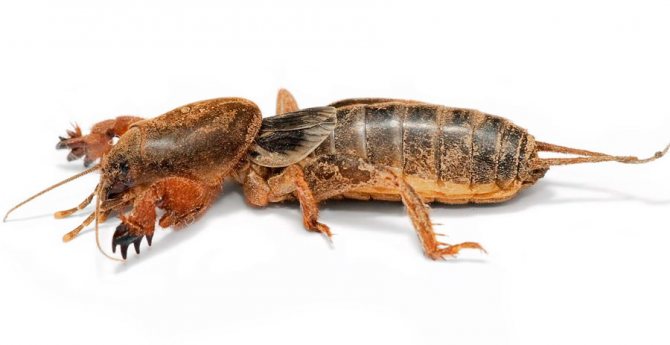

Among the people, this pest of vegetable gardens is called a cabbage, because it eats with pleasure both the leaves and the heads of cabbage. It is possible that there are other names as well.
Typical signs of a bear:
- The body of the pest has a hard brown shell, reminiscent of the shell of crustaceans.
- An adult insect is nearly impossible to crush compared to other pests.
- The insect is distinguished by its frightening appearance due to the front legs with outgrowths, whiskers, processes at the end of the abdomen, which are similar to the stove grip and a large head.
- If there is enough food, then some specimens reach 6 cm in length, or even more.
- The crustacean larvae are rather large. Their body is distinguished by a milky white tint with spots on the sides. The appearance is repulsive, since their body is thick, and their legs are short, the jaws are powerful, and the head is brown.
- The pest has powerful enough wings, which allows it to fly long distances in search of food.
- The female can lay up to hundreds of eggs at a time. Therefore, it is difficult even to imagine what kind of danger the bear poses for the garden. Since the insect is omnivorous, you should not even dream of a good harvest: the bear destroys and spoils tubers, roots of various shrubs, as well as greens.
Prevention of the appearance of a bear
In order not to waste time on energy-intensive fight against earth crayfish, I recommend paying attention to simple but effective means of preventing the appearance of a pest:
- Thorough autumn cultivation of the soil (digging, loosening). With this procedure, the eggs of the pest are forced out to the surface of the earth, destroyed. The insect rarely returns to the site where its passages are destroyed, the usual living conditions - it flies away to look for a more favorable place.
- Construction of natural barriers along the perimeter of the site. The pest will not be able to "break through" the developed root system of shrubs and trees. The pest especially does not like bird cherry and alder. If you are unable to plant these trees, make stakes out of their branches without peeling the bark. Stick the sticks to a depth of 20-30 cm, change them as they dry out.
- Planting garden flowers. Medvedki do not tolerate marigolds, chrysanthemums and calendula. Such a "green shield" can be planted along the borders of the ridges that are loved by the uninvited guest.
- Iodine opposition. Before sowing seeds of parsley, carrots and other root crops, the grooves are spilled with a solution of iodine: 20 drops per 10 liters of water.
- Onion and garlic. Medvedka is scared off by the smell of onion infusion, mashed heads of garlic.
- Odor protection. The pest does not like the sharp "aroma" of naphthalene, kerosene. These means "flavored" the sand, scatter it around the perimeter of the garden. A rather cardinal method is to bury pieces of rotten fish on the ridges chosen by the bear.
- Coniferous barriers. They do not tolerate the aroma of pine needles. Lay out fresh branches of spruce, pine, fir near the beds, change them as they dry out.
- Using noise effects. Hang ratchets, bells, bells, windmills, pieces of magnetic tapes around the perimeter of the site. The sounds they make scare away pests.
- Attracting natural enemies. From birds - starlings, crows, storks, rooks. From insectivorous animals - scolopendra, shrews, hedgehogs, ground beetles, lizards.
Tearing out long underground passages, flying at impressive distances. In order not to collide with him on your site, do not forget about preventive measures. If the bear has already settled in your garden, do not hesitate to destroy it. Otherwise, the intruder will easily leave you without the long-awaited harvest.
How to deal with a bear
In order to significantly reduce the likelihood of the appearance of a pest, it is necessary to perform agrotechnical techniques. Plowing of the soil should be carried out to a depth of at least 15-20 cm, and preferably twice a year - in spring and autumn. Such soil cultivation will help destroy the moves of the bear, destroy insect larvae and some of the pests themselves. And when plowing for prevention purposes, insects will not be able to winter and die. If the bear has already appeared in the garden, then in addition to agricultural technology, you can use the following methods for destroying the pest.
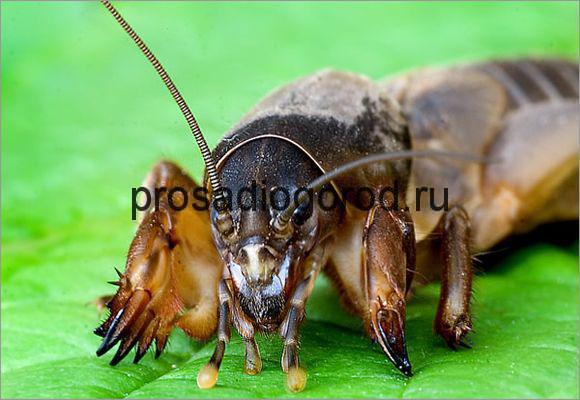

Catching with traps
Small glass jars can be used as traps. A bait is placed in them, it can be jam, honey, compote and so on. Traps are placed in different parts of the site for one day.
Then the traps can be collected together with the pests that have fallen into them. This method will allow not only to get rid of the bear, but also to estimate the approximate number of pests. In the fall, you can make a trap from manure and polyethylene. Small pits need to be dug around the perimeter of the site.
A piece of plastic wrap is laid out at the bottom of each hole and sprinkled with manure on top. Such a trap is the most attractive wintering place for the pest and they will all rush there. And in the spring, traps need to be taken out and destroyed. These holes can be used in the spring to kill insects. In May, the bears will rush to such places in order to lay as many larvae as possible. Therefore, having burned these pits, you can immediately destroy both adult bears and their offspring.
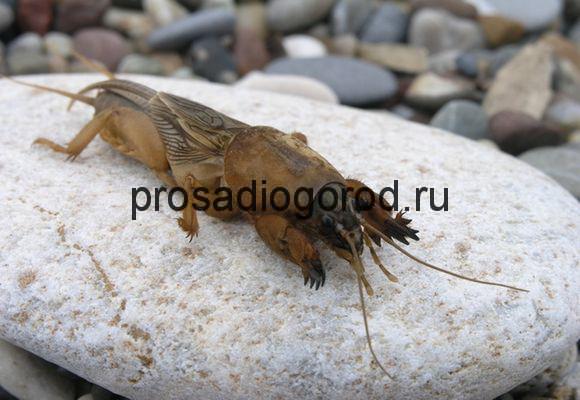

Egg shells with sunflower oil
The shell is well crushed and oil is added to it. Such a mixture is poured into the holes and holes of insects or sprinkled with seedlings. Then the bear will not touch the plants, fearing the sharp edges of the shell.
Treatment with poisonous solutions
To fight the pest, you can use washing powder, kerosene or chlorophos. These substances are diluted with water and the resulting solution is poured into the pest minks.
Burning
You can fight the pest by luring it to the surface and burning it. To do this, you need to spread old boards or pieces of plywood on the beds that have not yet been sown. Medvedki will crawl on them to warm up and then you can set fire to the boards and destroy the pests.
Use substances that scare away a bear
These insects do not like kerosene, and in order not to let them into the beds, you can spread branches or boards on the paths between them and pour kerosene over them. Then insects will quickly leave this area.
Fighting with chemicals
Not always folk remedies allow you to get rid of the bear forever. Such methods may have a short-term effect or not at all. With a large number of pests, the fight against them should be carried out with chemical preparations - insecticides. There is a wide selection of such drugs in specialized stores. But it is worth remembering that almost all of them will destroy not only the bear, but also beneficial insects. Therefore, it is best to use them in extreme cases, when folk remedies do not help.
Use protective rubber gloves, long-sleeved clothing and a mask or respirator for processing. You can use drugs Phenoxine or Thunder. These drugs are poisonous baits.
There are many more ways to fight the bear. For example, some gardeners prefer to fight the pest with boiling water, which is poured into tunnels or water pressure. Others wrap the roots of the seedlings with foil so that the insect does not damage them.
Fighting bear larvae
In early June, the bear begins to build a nest, in which it will then lay eggs. The nest can be seen on the surface of the earth with the naked eye. It resembles a hummock around which, within a radius of several tens of centimeters, the plants have died and died.
Breaking the ground at this point, you can find a nesting chamber with many yellowish eggs a little smaller than a pea. Medvedka often visits her clutch, looking after the eggs - she turns them over so that they do not become moldy. Mechanical destruction of the nest at this time is the main and most effective way of fighting the larvae.
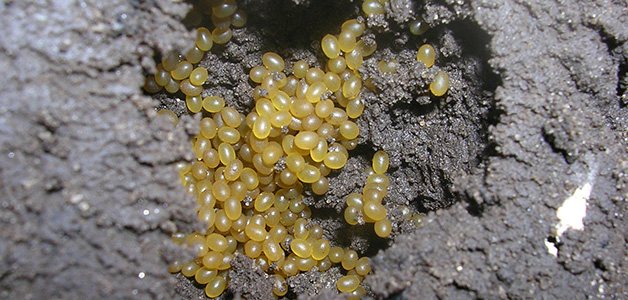

A month later, in early July, larvae hatch from the eggs and crawl underground in all directions. They love to live in greenhouses, as there is a warm and humid microclimate. Little bears, unlike adults, cannot fly, otherwise they would have settled around the neighborhood.
The bear larva looks like an adult insect and leads a similar lifestyle. She will become an adult in a year, having molted five times. But until that time, it will destroy many plants, many of which are cultivated.
A small bear is no less harmful to an adult. Methods of dealing with this dangerous insect must be combined. The fight can be mechanical or chemical.
In the southern regions, bear cubs lay eggs until September. It is better to fight the larvae that have settled on the site in a radical way, that is, chemical.Poisoned baits are used for destruction:
- Phenoxine, Medvetsid, Medvetox, Thunder - poured into the hole and cover the top with soil from birds. Young bears will gather for an attractive smell and taste poisonous granules.
- Boil half a kilo of any cereal, add 1 tbsp. "Odorous" vegetable oil and an ampoule of regent, karbofos, metaphos or zinc phosphide. Spread the bait under the ground on the site for 1 tbsp. for each bookmark.
Interesting Facts
In Zambia, bears are believed to bring good luck to those who see them. The people of Latin America say they predict rain when they dig the ground. In Japan, they were associated with worms, beetles that declare a person's sins to heaven according to the faith of Koushin.
Find out more What is head lice (louse smut) - from what appears, how to treat
Gryllotalpa species have been used as food in West Java, Vietnam, the Philippines, Thailand. They are usually eaten fried along with glutinous rice.
Traps for the bear in the gardens
Folk remedies include traps that can be made from bottles of liquid bait. For example, it can be diluted honey or molasses, as well as sour beer. These smells attract insects. As soon as the bear is caught with the trap, it must be destroyed, otherwise it will find a way to get out of the bottle.
Before planting potatoes, you can make potato peel traps. In the spring, holes are dug throughout the garden, bayonet-deep, chopped potatoes or peelings are placed in it. Sprinkle on top with humus, manure or grass. After constant examinations of the traps, the trapped bear must be destroyed.
Fresh manure traps can be made in the fall. To do this, tear holes 45-50 cm deep, cover them with foil and fill them with fresh fertilizer. As soon as it gets colder outside, insects gather in traps in considerable numbers. With the onset of frost, the bait is removed and scattered over the site, while the insects freeze and die. At least 4 traps are required per one hundred square meters of a vegetable garden.
Burrowing limbs of the bear
The bear has three pairs of limbs, consisting of a trochanter, a coxa, a lower leg, a thigh and three articulated legs.


The organ of hearing is located on the forelimbs (on the lower leg), just like in other Orthoptera - crickets, grasshoppers, and has a narrow slit-like shape.
The forelimbs of the bear have a special structure in the form of a bucket-shaped shovel and resemble a claw. With their help, she does an excellent job of paving a path underground.
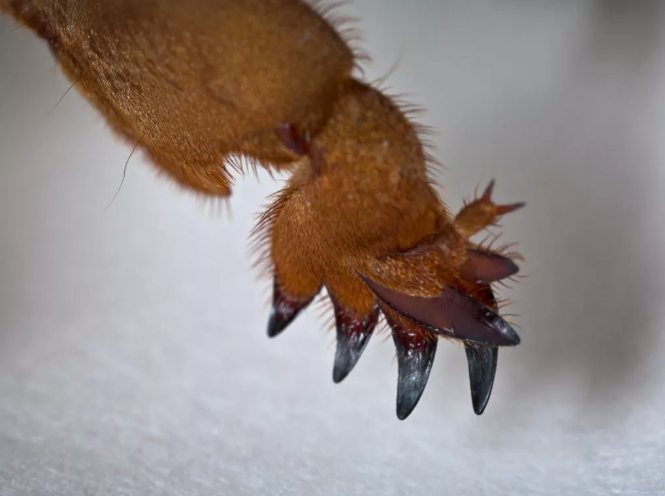

Due to the special structure of the front paws, the bear is called an insect with hands. Another nickname is the mole grasshopper, the bear earned for her love of digging.


The spiked hind feet are strong enough to aid movement.
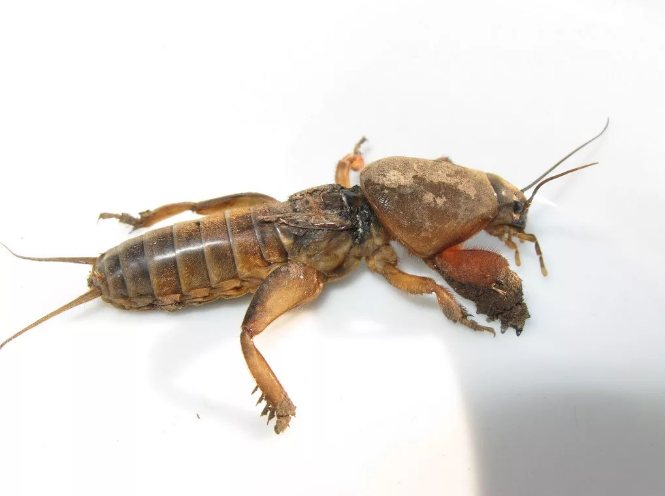

How to deal with a bear in the garden
Fighting the bear
You can understand that bears live on the site by looking at small mounds of peculiarly rolled lumps of soil on its surface, which are especially noticeable after rain. The greatest activity of these insects can be observed in May, when the bears crawl out of the already heated ground. It was at this time that shallow holes should be dug on the site and filled with chopped straw or fresh manure. Bears will crawl into egg-laying pits so that the hatched larvae can feed on manure or straw. After 3-4 weeks, the contents of the traps, together with the larvae, are removed and burned.
In order to destroy this dangerous insect, you need to find all the nests of the bear. Since they are not very deep, they can be found when digging
The nests are carefully dug up, placed in a bucket and then destroyed. Try to do this so that the female does not crawl to the surface.
Take a pesticide and spread its granules in all the passages leading from the nest - this way you will destroy the female too.
There is another way to get rid of the bear.As soon as you find the nest, fill it with soapy water so that it fills all the passages dug by the insect. Both the larvae and the female will die from the soap solution if she is in one of the passages. If she is not there, be prepared for the fact that after a while in the same place the female will again make a nest and lay eggs in it.
The soap solution is prepared as follows: 10 g of grated laundry soap and 50 g of washing powder are dissolved in a bucket of water. Instead of a soap solution for filling the passages, you can use water with vegetable oil - a tablespoon of oil is stirred in 4 liters of water - or water with kerosene - 100 g of kerosene per bucket of water at the rate of 30 g of solution for each hole.
If the bears were found by you towards the end of the growing season, wait until autumn and at a soil temperature of at least 8 ºC, dig trapping pits 50-60 cm deep, line the bottom and walls of the pits with plastic wrap, fill them with manure that has begun to sweep and cover with an impromptu lid. As soon as persistent frosts set in, remove the manure from the pits along with the bears that crawled into a warm shelter for the winter, and scatter it over the site. The bears will die from frost, because already at a temperature of +5 ºC they become inactive.
Remedies for Medvedka (preparations)
The fight against bears in the garden is also carried out with pesticides, however, chemical preparations for bears are used only as a last resort, when other methods of struggle have turned out to be ineffective. Several effective remedies for bear are known:
Medvetox is a unique granular preparation with an attractive taste for insects and a killer effect
To die, it is enough for a bear to eat just one pellet;
A bear bug is one of the most effective remedies for a bear that does not have a harmful effect on the environment, which is used in the form of a solution;
Chops is an effective and relatively safe remedy for a bear in the form of brightly colored granules, which are laid out in the passages dug by the pest;
Thunder - this drug is effective, but it includes carcinogens, so it must be used with caution, laying out 3-4 granules in the moves of the bear;
Grizzly - bread-colored granules based on Diazinon, which are used with great care, laid out in the passages dug by the bear;
Bankol is an insecticide of contact-intestinal action, low toxic to humans, immobilizing the insect, which makes it impossible to receive food and leads to death in 2-3 days;
Phenoxin plus - granules with an attractive aroma and taste for the pest, which should be used pointwise, placing several pieces in the passages dug by bears;
Boverin is a biological drug that causes a fatal illness in a bear. Boverin's advantage is that it is harmless to warm-blooded animals and beneficial insects.
The harm caused by the bear


The problem is that the pest eats everything that grows in the garden. The underground parts of cultivated plants especially suffer from its vital activity.
The diet of earth crab includes:
- Potatoes.
- Shrub roots.
- Carrot.
- Eggplant.
- Radish.
- Beet.
- Cabbage.
- Radish.
- Hemp.
- Tomatoes.
- Pepper.
- Parsley roots.
- Various flowers.
Since the bear spends most of her life in the ground, she breaks through multi-level passages in it. Here in the ground is her nest, where she lays eggs.
The pest has powerful enough jaws, which allows it to eat the roots of various shrubs. If several bears settled on the site and larvae appeared, then this is a serious emergency. It is urgent to take measures to get rid of such a neighborhood in the garden.
Medvedka multiplies quickly and in large quantities. Larvae, as well as adults, begin to destroy and spoil the underground parts of plants.
It's important to know! Kapustyanka hibernates in the ground, as close to the plant roots as possible.With the arrival of heat, the pests immediately begin to feed on the roots of these plants. It is better to destroy these pests in spring or autumn, when they have not yet begun to multiply.
Effective ways to get rid of a bear on the site
Fighting a bear in the garden is like fighting cockroaches in an apartment. It can only be overcome by the joint efforts of all neighbors. Fighting in a separate area can bring only a temporary decrease in the pest population, since the place of the destroyed insects will soon be taken by aliens from neighboring areas. First of all, it is necessary to apply preventive agricultural techniques:
- Late autumn digging or plowing of the soil. At this time, the insects have already settled down for the winter in their nests, which they have equipped in the upper layers of the soil (up to 10-15 cm). In the process of digging with the overturn of the layers of the earth, the pests will be lifted up, where they will die from frost. Of course, it will not be possible to completely get rid of the bear in this way, since sometimes it goes too deep, but it will turn out to cause significant damage to the population.
- In the fall, several holes up to 50 cm deep and about the same diameter are made on the site. They are filled with fresh warm manure, which will surely collect most of the pest representatives for wintering in such comfortable conditions. At the onset of frost, manure is scattered with a shovel over the site along with the "guests" who will die from the frost.
- Plants are planted on the site, the smell of which scares off the bear: marigolds;
- onion;
- calendula;
- garlic;
- chrysanthemum.
Store drugs
For fans of radical chemical attacks, there are many drugs. They are quite effective, only before using them, you should carefully study the composition and rules for working with them, so as not to harm plants, humans, pets. And besides, there are electronic scarers of underground pests such as Rubezh, Tornado, Thunder and others on sale.
Table: preparations for fighting a bear
| Name of the drug | Active substance | Description | Validity |
| Medvetox | Diazinon 20 g / kg | A popular drug that is red granules. Not phytotoxic. | Two weeks |
| Anti-Medvedka | Imidacloprid 50 g / kg | Release form - granules and microgranules. The drug is laid out in the furrows when planting plants or directly into the pest holes. Consumption of 300 grams per 20 acres. | Up to three weeks |
| Medvecid | |||
| Phenaxine plus | Malathion 50 g / kg | ||
| Rembeck | Kerosene, boric acid, red pepper | Granules. In addition to active substances, they contain baits: flavorings, sugar, vegetable oil, onion husks, cereals. | From 14 days to a month |
| Boverin | Spores of the muscardine mushroom Beauveria bassiana | The fungus penetrates the body of the bear, from which she dies | 7-14 days |
Photo gallery: preparations for fighting the bear
Folk remedies and traps
Folk remedies are mainly of a deterrent nature and at the same time they do not harm a person.
Kerosene
Dilute 0.5 cups of oil in 10 liters of water and in the evening pour this composition of 30-50 ml into each mink. It is advisable to combine this method with the following: pour 30 ml of kerosene into a bucket of dry sand, mix and sprinkle it on the paths between the beds.
Soapy water
10 g of laundry soap and 50 g of washing powder are diluted in a bucket of water. Pour 0.5 liters of solution into each hole. In a few minutes, the insects will either die underground or get out. In the latter case, they just need to be caught and destroyed.
Eggshell
The dried shell must be crushed in a mortar and then mixed with a small amount of sunflower oil. The mixture is used in the same way as granules - it is laid out in grooves when planting plants to a depth of 3-4 cm. Medvedka eats such a bait, seduced by the smell of oil, and dies because the sharp shell injures its insides.
Karbofos
Bait is made from steamed grain in an amount of 1 kg, which is mixed with 50 grams of malofos and 30 ml of sunflower oil. Since such baits are dangerous for birds and pets, they must be buried in the soil.
Calcium carbide
They put about 5 grams of this substance in each hole. With subsequent watering, acetylene will be released, which is fatal for the bear.
Traps
They take an ordinary bottle (plastic or glass) and bury it up to the neck in the ground. At the bottom of the bottle is poured 50-100 ml of beer or honey, dissolved in a small amount of water, or just sugar syrup. Insects, attracted by the smell, penetrate the bottle, from where they can no longer get out.


Bears love beer and sweet syrups
Protective rings
When planting seedlings, a rather effective method of protecting it from a bear is the use of plastic rings. Simply cut off a ring 8-10 cm high from a plastic bottle and deepen it into the soil around the plant. This is guaranteed to protect it from the pest.
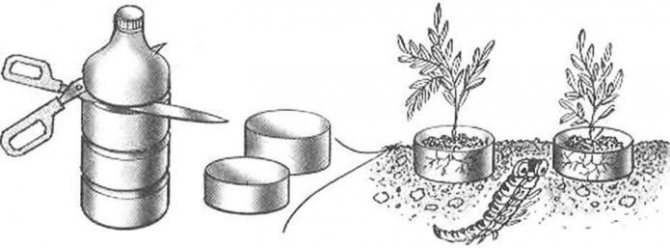

The plastic ring is guaranteed to protect the plants from the bear
Description of the bear of the most dangerous pest
Medvedka, both adults and larvae, is very dangerous for any plants, especially for young seedlings and seedlings. The insect lives in the ground and becomes active at night. By loosening the soil in the beds, it contributes to the death of plants, disrupting their root system. With the arrival of warm weather and before the onset of cold weather, the bear lives in the upper layers of the soil. For the winter, it is capable of going deep up to 2 meters underground. It feels especially comfortable in manure and compost heaps. It multiplies very quickly - lays up to 500 eggs in one nest. One insect can kill up to 15 seedlings.
Fighting the bear with folk methods
To prevent the appearance of a bear in the garden, you need to dig up the soil twice a year. The deeper you drive the shovel, the more likely it is that burrows and nests will collapse.
Oil and soap
A soapy solution or ordinary sunflower oil will help drive the bear out of the minks for further destruction. Walk around the site, carefully inspect the soil for underground passages and fill in each of them. Bears will quickly leave their homes, and their eggs will die.
Manure
This method is considered the most effective and, moreover, affordable. It is necessary to repeat the procedure every spring and autumn in order to completely remove the bear from your area. To set traps, dig holes 0.5 meters deep and fill them with manure. Medvedki love to be in it and rush to a cozy place.
With the onset of the first cold weather, the pits should be stirred up and the contents scattered over the soil surface. Bears during this period already hibernate and are very weak, therefore they quickly die in the cold.
It is advisable to stop using manure as fertilizer on your site, since it not only attracts the bear, but can also be their habitat. Alternatively, feed the soil with chicken droppings that are just as beneficial.
Beer
Insects love the smell of beer and honey, so you can use these foods as bait. Fill a glass jar or bottle with a narrow neck with a foamy drink or sweetened water, bury it in the ground, the bears will get there, but they won't be able to get out. Change the jar every day.
Sunbathing
Bears love to be in the sun, which allows them to be lured into a trap. Spread out pieces of black fabric over the area, as it attracts heat the most. Sprinkle the soil under the patches with water sweetened with honey and wait until the bears crawl under it. Further, it remains only to destroy the pests.
Fencing
Bears can only crawl on horizontal surfaces. Their legs are not adapted to overcome high obstacles.Therefore, it is advisable to fence off each bed with a net or a fence made of plastic bottles.
To protect the roots, you can put on a nylon stocking on each and plant it in the soil. The fabric stretches easily and does not interfere with the development of the root system, but will not miss a single bear.
Aromatic herbs
Pests are sensitive to pungent odors, so they avoid aromatic herbs and shrubs with pepper. Plant cilantro, garlic, chili, and onions throughout and around your garden to save your crop from the pest. An effective way to scare away bears is to water the soil with a decoction of onion husks.
Marigolds and chrysanthemums also tend to repel insects. Plant them on the site, and they will delight not only in appearance, but also in practicality. Another way that experienced summer residents offer is crushed eggshells. Spread it along the beds, and it will prevent the bears from crawling to the plants.
A fish
Bury fish heads around the beds every spring. Gradually, they will begin to rot and saturate the soil. Bears do not tolerate this smell and will not dare to approach your harvest.
Kerosene
Many gardeners recommend this method as the most effective one. Take a bucket of sand, drop a few drops of kerosene, stir. Dig small holes throughout the garden and pour the mixture into them.
Cooling the soil
Insects cannot stand the cold. If you want to scare them out of your garden, use a folk trick: sprinkle the ground with sawdust or straw. Light shades reflect heat and prevent the soil from heating up.
Wooden traps
Moisten the soil slightly and spread out wide planks or plywood sheets. Press them to the ground and wait a few days. During this time, the bears will fully master the new comfortable territory. If you turn the board over, you will find many individuals. Moreover, thinking that they are underground, all the passages will be dug only on its surface, and the bears will start to save themselves along them.
Unfortunately, folk methods will not help completely rid gardeners of the problem. They are only auxiliary methods of pest control and will temporarily save you from their invasion.
how to get rid of moles at their summer cottage
Misconceptions and truths about the bear
- Medvedka looks very frightening from a picture or photo. Therefore, some people have doubts: is the bear dangerous for humans?
In fact, the insect is a great danger exclusively for the garden and vegetable garden. The invasion of cabbage can leave the gardener without a flower garden, harvesting vegetables, fruit and berry crops.
- Is it possible to safely take a beetle with your bare hands, does the bear bite or not?
Powerful front pincers lead to this idea (about a bite), but the insect cannot pierce the human skin with them. The most you can get are unpleasant pinches and scratches. The mole cricket is not a poisonous insect.
- The question is, does the bear fly or not? Although the wings speak for themselves.
The bear flies, but not like a butterfly or a locust. She makes flights very reluctantly, in warm weather, over short distances. Up to 90% of flights are about finding a mating partner. By nature, the insect is a mole rat. It spends more than 2/3 of its life in the ground.
- Can the cabbage girls sing?
The mole cricket really chirps during the mating season, rubbing its wing against the wing, males make loud sounds that attract females.
Folk remedies for Medvedka
Those who prefer to protect their garden without "chemistry" will be interested to learn how to get rid of the bear with folk remedies. Unfortunately, they do not give a 100% result, but they are absolutely safe for the health of humans and pets.
Bread with matches
Lightly moisten black bread with water, mash and roll out of it several balls the size of a walnut. Stick 10-12 matches into each ball with sulfur heads inside.When the bread softens, take out the matches, and make smaller balls from the balls - the size of a pea. Scatter this bait around the garden and put a few pieces directly into the moves of the bear.
Beer or honey traps
Pour 100 g of beer or honey into a glass or plastic bottle (0.5 l) with a wide neck, dig the container into the ground at an angle at the place where the bear moves, cover the soil with a sheet of cardboard. Pests, moving along the tunnels made, will fall into a trap from which they will not be able to get out. When the jar is full, replace it with a new one.
It is recommended to place such traps at intervals of 4-5 meters.
Dung heaps
In early spring and during the autumn digging of the soil, spread manure heaps in the garden (preferably horse manure). Sensing warmth, the bears will crawl there and begin to lay eggs. As soon as you find insects there, burn the traps. So you will destroy the adults along with the larvae.
Soapy water
Add laundry or tar soap (100 g) to water (10 liters) and pour the resulting liquid in a small stream into the holes made by the bear, at the rate of 2 liters per stroke. Cut the insects that jump out of the hole with a shovel. The rest, who did not find a way out, will perish underground.
It is not recommended to use washing powder instead of soap, as it contains phosphates, synthetic fragrances and other additives that have no place in the soil.
Eggshell
Grind the pre-dried eggshell, pour with unrefined sunflower oil and place in the holes and grooves in which you are going to sow seeds or plant seedlings. Having eaten the shell, the bear will die. And uneaten residues will serve as an excellent organic fertilizer for the soil.
You will need a lot of shells, so start collecting it in the fall.
Scare off odors
Medvedka does not like the smell of some plants. Plant marigolds, calendula, chrysanthemums in the garden. Spread the branches of coniferous trees (pine, spruce, fir) between the beds, stick fresh branches of aspen or alder (always with bark) with a diameter of 2-4 cm into the soil to a depth of about 30 cm.
You can also prepare an infusion of onion peels and spill the moves of the bear on it. Or put cloves of garlic in the holes.
The bear also has natural enemies: starlings, crows, rooks, storks, hedgehogs. Attract them to the site - and your "allies" will significantly reduce the number of this underground pest.
What does the bear insect eat?
The fact that the bear is omnivorous is known. They feed on animal and plant foods. Their diet includes earthworms, insects and their larvae, humus, manure, seeds, stems and leaves of plants. The larvae feed in the same way, but their diet is less diverse due to poorly developed jaws.
Medvedka does not like strong aromas, so her diet does not include parsley, calendula, garlic, marigolds, alder. It is recommended to plant the beds with such plants to prevent the appearance of a bear.
All summer residents know that bears are a pest of garden crops - vegetables, berries, fruits. Basically, they damage the underground parts - tubers, roots, seeds, but they also do not disdain young plants. To a large extent, bears damage cucumbers, tomatoes, eggplants, peppers, turnips, watermelons, melons, cabbage, grapes and much more. In southern countries, this pest loves to eat tangerines, lemons, oranges (all citrus fruits), peanuts, tea, cotton. Bears also cause considerable harm to forests, tree roots suffer from them.
Other methods of dealing with a bear with folk remedies
Nowadays, you can apply many methods of dealing with a bear. In this number, you can also find folk remedies for fighting a bear. These methods of control may be ineffective, because this insect adapts very well to them. And depending on the soil and climate, the method of struggle may differ.
To begin with, you need to try a simple budgetary method of struggle.And if it turns out to be ineffective already resort to buying chemical baits. Perhaps, let's start with folk remedies for fighting a bear.
To do this, it is necessary to dig a hole in the fall near the vegetable garden 50 cm deep, wide and long, and fill it with manure. This hole will lure the bear to winter. When frosts come from -3 ° C and below, dig a hole and scatter the manure around the garden.
Banks against the bear
In the spring, when the planting season begins, jars are dug in next to the beds, flush with the ground, and water or, better, kvass (beer) is poured into it. During the night, bears often fall into them. Also, loosening the soil sometimes helps to fight the bear. The insect dies from the inventory tool when loosening.
Onion peel
From folk methods, sowing marigolds or chrysanthemums in your beds, you thereby scare away the bear from your garden. You can also advise to make an infusion of onion peel. To do this, pour about a kilogram of husk with 10 liters of water and leave for a week. Then the infusion is diluted 1: 2 and the garden is watered. This tool scares away the bear, and also fertilizes the garden with all the necessary microelements.
Pine needles
Medvedka is also afraid of needles. The branches of the needles are cut finely and scattered over the site. Medvedka will bypass your garden. You can grind the eggshells and mix them with sunflower oil. It is necessary to bury the bait to a depth of 1-2 cm and wait for the bear to feast on and die.
You can use cut-out plastic cups by digging them into the ground and sowing seeds. Medvedka will not harm lice seedlings in this way. However, it should be remembered that you thereby clog the beds with plastic, which does not rot for a long time.
Reproduction
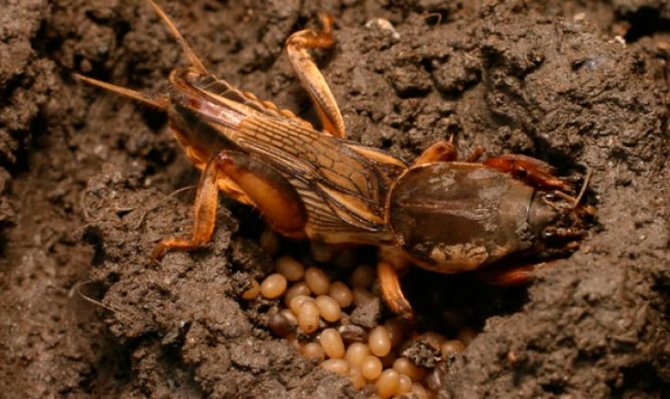

Bear's nest
After mating, the female rushes into her labyrinths, in which she prudently equips the masonry compartments. She is capable of laying an average of 30 to 60 eggs at a time.
Surprisingly, among all insects, for some reason, it is the bear that is endowed with a particularly strong maternal instinct. The entire period, from laying eggs to the appearance of offspring, and this is 2 - 3 weeks, she is in close proximity. During high humidity, the cabbage licks the masonry, thus preventing the appearance of mold and the death of nymphs. For the same reason, it seeks to destroy all vegetation near the egg compartment. Spots of bare soil with an area of 30 - 40 cm and small round holes, about 10 mm in diameter, signal to gardeners that an earth crust has settled here.
Subsequent mating takes place only after a few months.
Nymphs


Larvae of the bear
The hatched nymphs, similar to small spiders, are rather weak and helpless. They are completely blind and do not have the opportunity to eat "adult" food. However, after a month they acquire an external resemblance to their parents, with the only difference that their body color is much lighter, and they strive to expand the halo of habitation, gnawing everything in their path. Depending on the species and habitat, it takes from 1 to 3 years for nymphs to turn into sexually mature individuals.
Where is found
Medvedka is found on all continents, with the exception of Antarctica. Neoscapteriscus didactylus is a pest in South America, spread to the West Indies, New South Wales, Australia.
Learn more Formicaria for ants, features of keeping and feeding
Gryllotalpa africana is the main pest in South Africa. Other Gryllotalpa species are widespread in Europe, Asia, Australia, Britain.
Lives in Russia, other parts of the former USSR, China, Japan, Taiwan, India, Indonesia, the Philippines, Hawaii.
Ways to get rid of a bear in the garden
1. Use a bear remedy sold in specialized stores. Such funds have a granular appearance. When planting seedlings or sowing beds, it must be introduced into the soil next to the plantings to a depth of 3-5 cm.The preparations have a smell that attracts the insect, with the help of which it quickly finds the poison. After the parasite eats the pellets, it dies. However, the effect of the drugs lasts about a month, after which a new poison must be introduced.
2. Arrange traps by placing glass containers on the beds, slightly burying them in the ground. Foods that attract a pest are placed in containers, for example, potato peelings. When the bear enters the container, it is destroyed.
3. Scatter piles of manure over the area in early spring. When the snow melts, the air temperature rises, insects begin to lay eggs. Medvedka does this in fallen decayed foliage and dung heaps. After a couple of weeks, heaps are collected and destroyed along with the eggs laid.
4. You can scare off the pest in the simplest way - dig in aspen or alder branches around the perimeter of the site. It is believed that the insect does not tolerate the aroma of alder and aspen. To do this, it is enough to find the right tree, chop branches, dig into the ground to a depth of about 20-30 cm. Gradually, the bear will leave the garden.
5. Put in the crushed shells of fresh eggs. After such a delicacy, the insect dies, therefore, the crushed shell should be applied when planting seeds and seedlings directly into the hole. Considering that the shell is pure calcium, it is undesirable to additionally apply fertilizers containing this element.
6. Plant marigolds along the edges of the garden. These cute and cute flowers are loved by many gardeners, but the pest does not like their smell. If you make several rows of marigolds in different parts of the site, then the fight against the parasite will be greatly simplified.
7. Dig in small fish
The smell of fish is not tolerated by almost all insects, so this method should be used with caution, so as not to scare off bees pollinating plants. It is advisable to buy a small fish, slightly dig it between the beds or near the holes with planted crops
Of course, the aroma can spread throughout the garden, which is not very pleasant.
8. Scatter mothballs in places where there are no cultivated plants. It does not dissolve in water and has a specific aroma. The pest leaves the area where it is located.
9. Dig in the cloves of garlic around the perimeter of the beds. Like many other plants, garlic has a distinct aroma. You can also plan planting in the fall by planting garlic in such a way that it occupies the perimeter of the site.
If you do not fight the pest with a set of methods, then getting rid of it is almost impossible.

